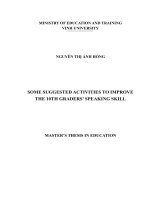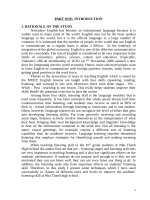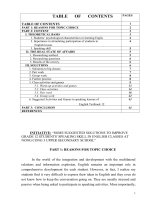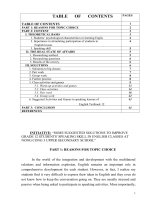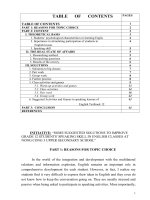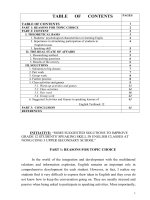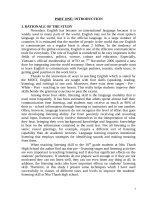Some suggested activities to improve the 10th graders speaking skill
Bạn đang xem bản rút gọn của tài liệu. Xem và tải ngay bản đầy đủ của tài liệu tại đây (702 KB, 121 trang )
MINISTRY OF EDUCATION AND TRAINING
VINH UNIVERSITY
NGUYỄN THỊ ÁNH HỒNG
SOME SUGGESTED ACTIVITIES TO IMPROVE
THE 10TH GRADERS' SPEAKING SKILL
MASTER’S THESIS IN EDUCATION
NGHE AN, 2014
2
2
2
MINISTRY OF EDUCATION AND TRAINING
VINH UNIVERSITY
NGUYỄN THỊ ÁNH HỒNG
SOME SUGGESTED ACTIVITIES TO IMPROVE
THE 10TH GRADERS' SPEAKING SKILL
Major: Teaching English to Speakers of Other Languages (TESOL)
Code: 60.14.01.11
MASTER’S THESIS IN EDUCATION
Supervisor: TRAN BA TIEN, Ph.D.
Nghe An, 2014
STATEMENT OF AUTHORSHIP
I hereby acknowledge that this study is my own work. The data and
findings discussed in the thesis are true, used with permission, and have not
been published elsewhere.
Author
Nguyen Thi Anh Hong
i
ACKNOWLEDGEMENTS
I gratefully acknowledge the encouragement and support of many individuals
in assisting me to accomplish this study.
First of all, I would like to thank my thesis supervisor: Dr. Tran Ba Tien for
his valuable time, suggestions, guidance, and assistance in this study. He always
guides me with valuable suggestions, helpful comments and whole-hearted guidance
during my implementation of this study. Without his help, the thesis would not have
been possible.
I also want to thank the cooperation of my colleagues and my students,
especially the students of class 10A1, 10A2, 10A3 at Le Viet Thuat high school in
Vinh city who have helped me to collect data for the study.
Last but not least, I would especially thank my family; my close friends who have
gave in their support and like to constant encouragement to fulfill my study. My thanks
go to my husband, his material and spiritual support throughout this study.
Vinh 2014.
Nguyen Thi Anh Hong
ii
ABSTRACT
This study aims at using of three stimulating activities: games, video and
role play to intensify students’ participation in speaking activities at Le Viet
Thuat high school.
The study was carried out in 10A1, 10A2, 10A3 class at Le Viet Thuat
high school in the second semester of the school year 2013-2014. The writer
took 107 students and 9 teachers as the subject of the research. The writer
taught speaking English using three stimulating activities: games, video and
role play. To find the results, the researcher got the information from the
students’ and teachers' answers on survey questionnaire, classroom
observations and interviews. The result of the research using three
stimulating activities: games, video and role play shows that, the students
become active and cooperative in learning speaking. The students’
motivation to speak and to practice speaking is stronger, and their
speaking skill is improved. Most of the students said that they like these
techniques. They became braver and felt more confident to speak and
express their feeling. Based on the findings, the writer also made some
recommendations on how to use three stimulating activities in class. As a
result, games, video and role play are highly recommended as effective
activities in the improvement of students’ speaking.
iii
TABLE OF CONTENT
Pages
STATEMENT OF AUTHORSHIP i
ACKNOWLEDGEMENTS ii
ABSTRACT iii
TABLE OF CONTENT iv
LIST OF ABBREVIATIONS vi
LIST OF FIGURES vii
Chapter 1
INTRODUCTION 1
1.1. Rationale of the study 1
1.2. Scope of the study 2
1.3. The aims of the study 2
1.4. Research questions 3
1.5. Method and procedure of the research 3
1.6. Design of the study 3
Chapter 2
THEORETICAL BACKGROUND 5
2.1. Communicative language teaching 5
2.1.1. What is meant by communication? 5
2.1.2. Communicative language teaching 5
2.1.3. Communicative Competence - The desired goal of CLT 7
2.1.4. The necessity of teaching and learning speaking skill in a
Communicative Class 8
2.1.5. Nature of communicative language teaching 9
2.2. Theoretical background of speaking 11
2.2.1. What is “speaking”? 11
2.2.2. The nature of speaking 12
2.2.3. The role of speaking skill in communication approach 13
2.2.4. Characteristics of a successful speaking activity 14
2.2.5. Principles in teaching speaking in CLT 14
2.2.6. Problems in teaching and learning speaking skill 15
2.2.7. Factors affecting English speaking abilities 16
2.3. Theoretical background of activities 17
2.3.1. Stimulating activities 17
2.3.2. Types of stimulating activities in teaching speaking skills 18
2.3.3. Three most stimulating activities in speaking class 20
Chapter 3
METHODOLOGY 25
3.1. Research context 25
iv
3.1.1. An overview of the research site 25
3.1.2. Description of the students at Le Viet Thuat High school 25
3.1.3. Description of the teachers at Le Viet Thuat High School 26
3.1.4. The textbook 26
3.2. Participants 30
3.3. Research instruments 30
3.4. Data analysis 32
3.5. Conclusion 32
Chapter 4
FINDING AND DISCUSSION 33
4.1. Presentation and analysis of data 33
4.1.1. Pre-task questionnaire for students 33
4.1.2. Questionnaire for teachers 40
4.2. Post-task questionnaire for students 43
4.2.1. Analyzing result of post-survey questionnaire 43
4.3. Analyzing results of classroom observations 47
4.3.1. From the experimental teaching observation 47
4.3.2. From the teacher observation 48
4.4. Problem in speaking lessons when use three stimulating activities:
games, video and role play 51
4.5. The obstacles during the use of three stimulating activities: games,
video and role play in speaking class 51
4.6. Discussion 51
4.6.1. Difficulties from the teachers and students 51
4.6.2. Solutions to improving 10th graders’ speaking skill 56
4.7. Summary 58
Chapter 5
CONCLUSION 59
5.1. Summary of the study 59
5.2. Recommendations on how to use three stimulating activities in class.60
5.2.1. For the teacher 60
5.2.2. For the administrator 63
5.3. Limitation of the study 64
5.4. Suggestions for further research 64
REFERENCES 65
APPENDIX
v
LIST OF ABBREVIATIONS
% : Percent
CLT : Communicative Language Teaching
EFL : English as Foreign Language
MOET : Ministry of education and training
No : Number
R : Researcher
Ss : Students
vi
LIST OF FIGURES
Pages
Figure 4.1. Student’s opinions towards speaking 33
Table 4.1. Students’ opinions towards the speaking tasks of the new textbook
34
Figure 4.2. Frequency of students’ speaking participation 36
Figure 4.3. Students’ self-improvement of speaking skill 36
Table 4.2a. The frequency of using techniques 38
Table 4.2b. Students’ opinions towards teachers’ teaching speaking techniques
38
Table 4.3. Students’ difficulties in speaking lessons 39
Table 4.4. Teachers’ difficulties in teaching English speaking skills 40
Table 4.5. Teachers’ solutions to the problems 42
Table 4.6a. Students’ feeling and attitudes towards stimulating activities
exploited by the teacher 43
Table 4.6b. Students’ feeling and attitudes towards stimulating activities
exploited by the teacher 44
Table 4.6c. Students’ feeling and attitudes towards stimulating activities
exploited by the teacher 45
Table 4.6d. Students’ feeling and attitudes towards stimulating activities
exploited by the teacher 45
Table 4.6e. Students’ feeling and attitudes towards stimulating activities
exploited by the teacher 46
Table 4.7. Students’ participation in stimulating activities 46
Table 4.8. The effects of stimulating activities in learning speaking lesson to
students 47
vii
Chapter 1
INTRODUCTION
1.1. Rationale of the study
Language education, especially foreign language teaching and learning, is a
compulsory in every country. With the development of the market economy and the
globalization trend, learning foreign languages has become not only an interest but
also a great demand for most people in Viet Nam.
Since 2006, the Ministry of Education and Training(MOET) has introduced
the new English textbook to high school students throughout the country. In general,
these new textbooks achieved the goal of teaching English through a communicative
approach. Each unit contains four skills: listening, speaking, reading and writing,
with various interesting topics relevant to the age of students. The new textbooks
have many advantages; however, both the teachers and students face a lot of
challenges in the process of working with the new English textbooks. It seems that
they do not fulfill the requirements of the new textbooks at all.
More ever, one of the main tasks assigned to foreign language teaching at
school is that of training students to be communicatively competent. “The aims of
foreign language instruction, especially English language instruction, is commonly
defined in terms of four essential skills, reading, writing, listening and speaking, of
which speaking is becoming the most important aspect in developing one's
communicative competence (Moore, 1992, p.9).
Speaking is “the process of building and sharing meaning through the use of
verbal and non-verbal symbols, in a variety of contexts.” (Chaney,1998, p.13). In
any second language teaching and learning, speaking is always believed to be the
most vital skill. Learning a target language makes no sense if you can not
communicate in it successfully.
However, due to some objective and subjective reasons, teaching and learning
English in general and teaching and learning speaking in particular does not come
1
up to the study goals. A great deal of researchers has shown the students are often
hesitant and anxious about speaking the target language in class. Despite teachers'
efforts to provide students with opportunities to develop their communicative skills,
how to teach and learn speaking skill effectively is still a challenging question to
both teachers and students to many high schools in Viet Nam.
As a teacher of English at Le Viet Thuat high school in Vinh city, I also have
the same difficulties. I find the new textbooks more effective than the old ones
that were used years ago. However, my teaching seems to encounter a significant
problem: the students do not pay more attention to their speaking skill, they
usually keep quiet in speaking lessons or they often use mother tongue instead
speaking English.
Against the problem above, some suggested activities should be used to
overcome them. I am interested in applying these activities to improve the speaking
skill of Le Viet Thuat high students in English classes based on the syllabus of
MOET so that I will conduct the research entitled “ Some suggested activities to
improve the 10th graders' speaking skill”. My objective is to find the most effective
ways of helping them to overcome the barrier of low self confidence when studying
speaking skill.
1.2. Scope of the study
This research mainly covers the problems with the speaking skill that teachers
and students have in the process of using the text book for grade 10. These problems
were discussed throughly in order to discover the causes and to offer some
suggested activities.
The study only focuses on using three stimulating activities: games, video
and role play to improve English speaking skills 10th graders at Le Viet Thuat
high school.
1.3. The aims of the study
To find out the difficulties in teaching and learning English speaking skill that
10th graders and English teachers at Le Viet Thuat high school have encountered.
2
To suggest some recommendations how to use three stimulating activities:
games, video, role play to enhance students in speaking skill and develop
communicative skill.
1.4. Research questions
1. What are the difficulties encountered by the English teachers and the 10th
graders in teaching and learning English speaking skill at Le Viet Thuat high
school?
2. How to use three stimulating activities: games, video and role play to
overcome these difficulties?
1.5. Method and procedure of the research
A combination of qualitative and quantitative methods were used for this
research. Two survey questionnaires were used to collect data for the study.
The first survey questionnaire was carried out on 107 10th graders from 3
classes at Le Viet Thuat high school.
The second one is carried out on 9 teachers of Le Viet Thuat high school.
1.6. Design of the study
Chapter I:Introduction: consists of the rationale, the aims, the method and
design of the study. The research questions are also mentioned in this part.
Chapter II: Literature review gives the theoretical background of CLT,
speaking skill and stimulating activities.
Chapter III: Presents the use of stimulating activities to improve the 10th
graders' speaking skill at Le Viet Thuat high school. It provides the current situation
of teaching and learning English speaking skill at Le Viet Thuat high school and a
research on the use of stimulating activities. It gives research methodology which
consists of research questions and participants of the study. It also gives research
instruments, data collection procedures, technique for analyzing data.
Chapter IV: Provides discusses the findings of the study, data analysis and
findings through an analysis of all data collected by means of classroom
observation, post-survey questionnaire and individual interviews. In this chapter, the
3
writer describes the process of teaching speaking through stimulating activities such
as: games, video, role play at Le Viet Thuat high school.
Chapter V: Conclusion: summarize the main points which have been
explored in the study and made some recommendations on how stimulating
activities should be used to improve the 10th graders. It also discusses the
limitations of the study and makes some suggestions for further research.
4
Chapter 2
THEORETICAL BACKGROUND
In this chapter, theoretical background relative to the topic and surveys of
articles, books and other resources relevant to a particular the study topic will be
presented. This part will also provide description, summary, and critical evaluation
of each work quoted.
2.1. Communicative language teaching
2.1.1. What is meant by communication?
In Thompson's book (2003, p. 9) “Communication and Language”, he
considers that “Communication is such a well-integrated part of our day-to-day
existence that we tend to take it for granted rarely pausing to consider what it
involves or just how important it is to us”.Before he expressed to his own ideas
about communication, he mentioned some of Fiske's ideas:
“Communication is one of those human activities that everyone recognizes but
few can definite satisfactory.” (Fiske, 1990, p. 1)
“Communication is too often taken for granted when it should be taken to
pieces,”(Fiske, 1994, p. 8)
Thompson noticed “I quickly recognize that communication is used in a
number of senses and at a number of levels to indicate the transmission of
information or even, as in the transport networks example, the transmission of
goods and people.” (Thompson, 2003, p. 10).
However, he completely agreed with Fiske's ideas that:”the most relevant definition
of communication for present purposes is social interaction through messages”
(Thompson, 2003, p. 10).There are two related aspects that we should consider when
talking about definition of communication is “social” and “interaction”.
2.1.2. Communicative language teaching
The history of language learning and teaching methods has experienced
many changes with many approaches, such as Grammar - Translation Method,
5
Reading Method, Audio lingualism, and Affective - Humanistic Approach and,
etc. CLT is the latest influence on teaching methodology which has been put forth
around the world as a new or innovative approach to teach English as a second or
foreign language. CLT appeared in the late 1960s due to the changes in the British
language teaching tradition. Until then, situational language teaching remained the
major approach in British approach to teaching. The need for communicative
proficiency rather than mere mastery of structures made scholars advocate this
view of language teaching.
*David Nunan’s definition of CLT:
CLT views language as a system for the expression of meaning. Activities
involve oral communication, carrying out meaningful tasks and using language that
is meaningful to learners. Objectives reflect the need of the learners: they include
functional skills as well as linguistic objectives. The learners’ role is as a negotiator
and integrator. The teachers’ role is as a facilitator of the communication process.
Materials promote communicative language use; they are task - based and authentic.
(David Nunan, 1989, p. 194)
*Characteristics of CLT:
CLT has six features for most modern approaches and methods, which are
learner - centered teaching, cooperative learning, interactive learning, whole -
language education, content - centered education and task - based learning. Besides,
Littlewood (1981, p. 1) states: “one of the most characteristic features of
communicative language teaching is that it pays a systematic attention to functional
as well as structural aspects of language”. For other theorists, communicative
language teaching means using procedures where learners work in pairs or groups
employing available language resources in problem solving tasks.
David Nunan (1991, p. 279) offers five characteristic features of CLT:
• An emphasis on learning to communicate through interaction in the
target language.
• The introduction of authentic texts into the learning situation.
6
• The provision of opportunities for learners to focus not only on
language but also on the learning process itself.
• An enhancement of the learners’ own experience as important
contributing elements to classroom learning.
• An attempt to link classroom language with language activation outside
the classroom.
These five features are claimed by practitioners of CLT to show that they are
very interested in the needs and desires of their learners as well as the connection
between the language as it is taught in their class and as it used outside the
classroom. Under this broad umbrella definition, any teaching practice that helps
students develop their communicative competence in an authentic context is
deemed an acceptable and beneficial form of instruction. Thus, in the classroom
CLT often takes the form of pair and group work requiring negotiation and
cooperation between learners, fluency-based activities that encourage learners to
develop their confidence, role-plays in which students practice and develop
language functions, as well as judicious use of grammar and pronunciation focused
activities.
2.1.3. Communicative Competence - The desired goal of CLT
When teaching a language, the most important goal is to help the pupils to
obtain the ability to communicate. Therefore, as an effective approach in language
teaching, CLT puts communicative competence on the top of its objectives.
The concept of communicative competence was introduced in 1964 and since
then it has caught much attention from linguists all over the world. Communicative
language teaching is an approach that aims to make communicative competence the
goal of language teaching. That is to help students use language appropriately in
real communication. Rivers (1981, p. 15) and those who work with foreign
language teaching in U.S tend to define communicative competence as simply
linguistic interaction in the target language: “The ability to function in a truly
communicative setting; that is in a spontaneous transaction involving one or more
7
other persons”. People who work in ESL, on the other hand, tend to use
communicative competence in Hymes’ sense. In his view, a person who acquires
communicative competence acquires both knowledge and ability for language use
with respect to
• Whether (and to what degree) something is formally possible.
• Whether (and to what degree) something is feasible in virtue of the
means of implementation available.
• Whether (and to what degree) something is appropriate (adequate,
happy, successful) in relation to a context in which it is used and
evaluated)
• Whether (and to what degree) something is in fact done, actually
performed and what its doing entails.
A more recent but related analysis of communicative competence is found in
Canale and Swain (1980), which identified four dimensions of communicative
competence: Grammatical competence, Socio linguistic competence, Discourse
competence and Strategic competence.
To sum up, communicative competence is the ability to use the language
correctly, appropriately in any particular circumstances of communication. It is the
goal of language teaching and it makes CLT different in scope and status from any
other approaches.
2.1.4. The necessity of teaching and learning speaking skill in a Communicative Class
Speaking is fundamental to human communication. Just think of all the
different conversations we have in one day and compare that with how much
written communication we do in one day. Which do we do more of? In our daily
lives most of us speak more than we write. Therefore, if the goal of the language
course is truly to enable the students to communicate in English, then speaking skill
should be taught and practised in the language classroom. Speaking is a skill which
deserves attention in both first and second languages. The learners often need to be
able to speak with confidence in order to carry out many of their most basic
8
transactions. It is the skill by which they are most frequently judged. It is the
vehicle par excellence of social solidarity, of social ranking, of professional
advancement and of business. It is also a medium through which much language is
learnt, and which for many is particularly conductive for learning. Therefore, the
teaching of speaking merits more thought.
Many language learners regard speaking ability as the measure of knowing a
language. These learners define fluency as the ability to converse with others, much
more than the ability to read, write, or comprehend oral language. They regard
speaking as the most important skill they can acquire, and they assess their progress
in terms of their accomplishments in spoken communication. The necessity of
learning and teaching speaking skill was emphasized by Nunan (1991): "success is
measured in terms of the ability to carry out a conversation in the (target)
language." Therefore, if students do not learn how to speak or do not get any
opportunity to speak in the language classroom they may soon get unmotivated and
lose interest in learning. On the other hand, if the right activities are taught in the
right way, speaking in class can be a lot of fun, raising general learner motivation
and making the English language classroom a fun and dynamic place to be.
In the communicative model of language teaching, instructors help their
students develop this body of knowledge by providing authentic practice that
prepares students for real-life communication situations. They help their students
develop the ability to produce grammatically correct, logically connected sentences
that are appropriate to specific contexts, and to do so using acceptable (that is,
comprehensible) pronunciation. The goal of teaching speaking skills is
communicative efficiency. Learners should be able to make themselves understood,
using their current proficiency to the fullest. They should try to avoid confusion in
the message due to faulty pronunciation, grammar, or vocabulary, and to observe
the social and cultural rules that apply in each communication situation.
2.1.5. Nature of communicative language teaching
Communicative language teaching means little more than an integration of
9
grammatical and functional teaching. Littlewood (1981, p. 1) states, “One of the
most characteristic features of communicative language teaching is that it pays
systematic attention to functional as well as structural aspects of language”.
Communicative language teaching stresses the importance of providing the
learners with opportunities to use English for communicative purposes and attempts
to integrate such activities into a wider program of language teaching.
2.1.6. The techniques of communicative language teaching
The techniques of communicative language teaching are described by features.
Nunan (1991a, p. 279) gives five features to characterize CLT:
• An emphasis on learning to communicate through interaction in the
target language.
• The introduction of authentic texts into the learning situation.
• The provision of opportunities for learners to focus, not only on
language but also on the learning process itself.
• An enhancement of the learner's own personal experiences as important
contributing elements to classroom learning.
• An attempt to link classroom language teaching with language
activation outside the classroom.
According to Richard and Rogers(1986, p. 170), communicative principles can
be applied to the teaching of any skills and at any levels. Because of the wide
variety of classroom activities and exercise types discussed in the literature on
communicative language teaching, description of typical classroom procedures used
in a lesson based on CLT principle is not feasible. Savignon (1984) discusses
techniques and class management procedures associated with a number of CLT
classroom procedure (e.g. group activities, language games, role plays), but neither
these activities nor the ways in which they are used are exclusive to CLT
classrooms.
Johnson and Johnson (1989) offer five core characteristics that underlie
current applications of communicative methodology:
10
• Appropriateness: Language use reflects the situations of its use and
must be appropriate to that situation depending on the setting, the roles
of the participants and the purpose of the communication, for example.
Thus learners may need to be able to use formal as well as casual styles
of speaking.
• Message focus: Learners need to be able to create and understand
messages, that is, real meanings. Hence the focus on information
sharing and information transfer in CLT activities.
• Psycholinguistic processing: CLT activities seek to engage learners in
the use of cognitive and other processes that are important factors in
second language acquisition.
• Risk taking: Learners are encouraged to make guesses and learn from
their errors. By going beyond what they have been taught, they are
encouraged to employ a variety of communication strategies.
• Free practice: CLT encourages the use of “holistic practice” involving
the simultaneous use of a variety of sub-skills, rather than practicing
individual skills one piece at a time.
To sum up, communicative language teaching is best considered an approach
rather than a method. It refers to a diverse set of principles that reflect a
communicative view of language and language learning and that can be used to
support a wide variety of classroom procedures.
2.2. Theoretical background of speaking
2.2.1. What is “speaking”?
There are many definitions of speaking. According to Chaney, (1988, p. 13)
speaking is “the process of building and sharing meaning through the use of verbal
and non-verbal symbols, in a variety of contexts”. According to other researchers
such as Brown (1994), Burn and Joyce (1997), speaking is “an interactive process
of constructing meaning that involves producing and receiving and processing
information”. In a related study, Bygate (1987) had a detailed definition which
11
states that “speaking is the skill by which learners are most frequently judged and
through which they make and lose friends. It is the vehicle par excellence of social
solidarity, social ranking, of professional advancement and of business. It is also the
medium through which much language is learned”.
2.2.2. The nature of speaking
It is obvious that speaking is the key to communication and seems to be the
vital skill in comparison with reading, listening and writing. Everywhere people
speak to each other to exchange attitudes, cultural values, etc. Without it
communication will become difficult to proceed and our world will become as
silent as a grave. Therefore, classroom activities aiming at developing learners'
ability to express themselves through speech are considered an important
component in a language school curriculum.
There have been many scholars discussing the nature of speaking. To Brown
(1994), Burn and Joyce, (1997), speaking is an interactive process of constructing
meaning that involves producing, receiving and processing information; Its form
and meaning are dependent on the context in which it occurs, including the
participants themselves, their collective experience, the physical environment, and
the purposes for speaking; it is often spontaneous open ended and evolving.
However, speaking is not always unpredictable. Language functions that tend to
recur in certain discourse situations (declining an invitation, requesting time) can be
identified and charted. For example, when a salesman asks,“May I help you?”, the
expected discourse sequence include a statement of need, response to the need, offer
of appreciation, acknowledgements of appreciation, and a leave- taking exchange.
Speaking requires that learners not only know how to produce specific points of
language, such as grammar, pronunciation or vocabulary (linguistics competence),
but also that they understand when, why, and in what ways to produce language
(sociolinguistics competence).
According to Byrne (1976, p. 8), speaking is a two-way process between the
speakers and the hearers involving the productive skill of speaking and the receptive
12
skill of understanding. Both the listener and the speaker have a positive function to
perform. The speaker has to encode the message to be conveyed in appropriate
language, while the listener has to decode the message. The message itself in
normal speech usually contains a great deal of information that the listener needs.
It is perfectly true that speaking is active, or productive, and makes use of
aural medium. An act of speaking is commonly performed in face-to-face
interaction. The act of speaking involves not only the production of sounds but also
the use of gestures, the movements of the muscles and the face. Spoken language
consists of short, often fragmentary utterances, in a range a pronunciation. There is
often a great deal of repetition and overlap between one speaking and another.
Speakers frequently use non-specific references.
Some of the micro-skills involved in speaking. The speaker has to:
• Pronounce the distinctive sounds of a language clearly enough so that
people can distinguish them. This includes making tonal distinctions.
• Use stress and rhythm patterns and intonation patterns of the language
clearly enough so that people can understand what is said.
• Use the correct forms of words. This may mean, for example, changes
in the tense, case or gender.
• Put words together in correct word order.
• Use vocabulary appropriately.
• Use the register or language variety that is appropriate to the situation
and the relationship to the conversation partner.
• Make clear to the listener the main sentence constituents, such as
subject, verb, object, by whatever means the language uses.
• Make the discourse hang together so that people can follow what you
are saying.
2.2.3. The role of speaking skill in communication approach
In my opinion, those who think the major objective of the students is reading
not speaking have ignored some obvious pedagogical facts:
13
Firstly, people have the notion that learning English has something to do with
oral English. When one says some students are good at English, people will
naturally think he or she can speak English well.
Secondly, oral English can be very useful for the development of reading and
writing skills. Rivers points out: “When we read and write, we can call upon what
we know of the language orally”, (Rivers, 1968, p. 20). He goes on to say that there
must be a connection between reading and speaking. If the students are reading, and
then they are using their oral English, too. If a student has poor English, his reading
ability may also be poor. Similarly, Rivers (1968) argues that writing involves oral
ability as well.
2.2.4. Characteristics of a successful speaking activity
There are some characteristics of a successful speaking activity which are
introduced by Ur (1996, p. 120) as follows.
+ Learners talk a lot: As much as possible of the period of time allotted to the
activities is in fact occupied by learner talk. This may seem obvious, but often most
time is taken up with teacher talk or pause.
+ Participation is even: Classroom discussion is not dominated by a minority
of talkative participants: all get a chance to speak, and contribution are fairly evenly
distributed.
+ Motivation is high: Learners are eager to speak: because they are interested
in the topic and have something new to say about it, or because they want to
contribute to achieving a task objective.
+ Language is of an acceptable level: Learners express themselves in
utterances that are relevant, easily comprehensible to each other, and of acceptable
level of language accuracy.
2.2.5. Principles in teaching speaking in CLT
Language educators and teachers have made great efforts to find out the main
principles of teaching speaking.
According to Larsen Freeman (1986, p. 77) “…the challenge for the teacher is
14

